engine AUDI A8 2013 Owners Manual
[x] Cancel search | Manufacturer: AUDI, Model Year: 2013, Model line: A8, Model: AUDI A8 2013Pages: 318, PDF Size: 79.34 MB
Page 285 of 318
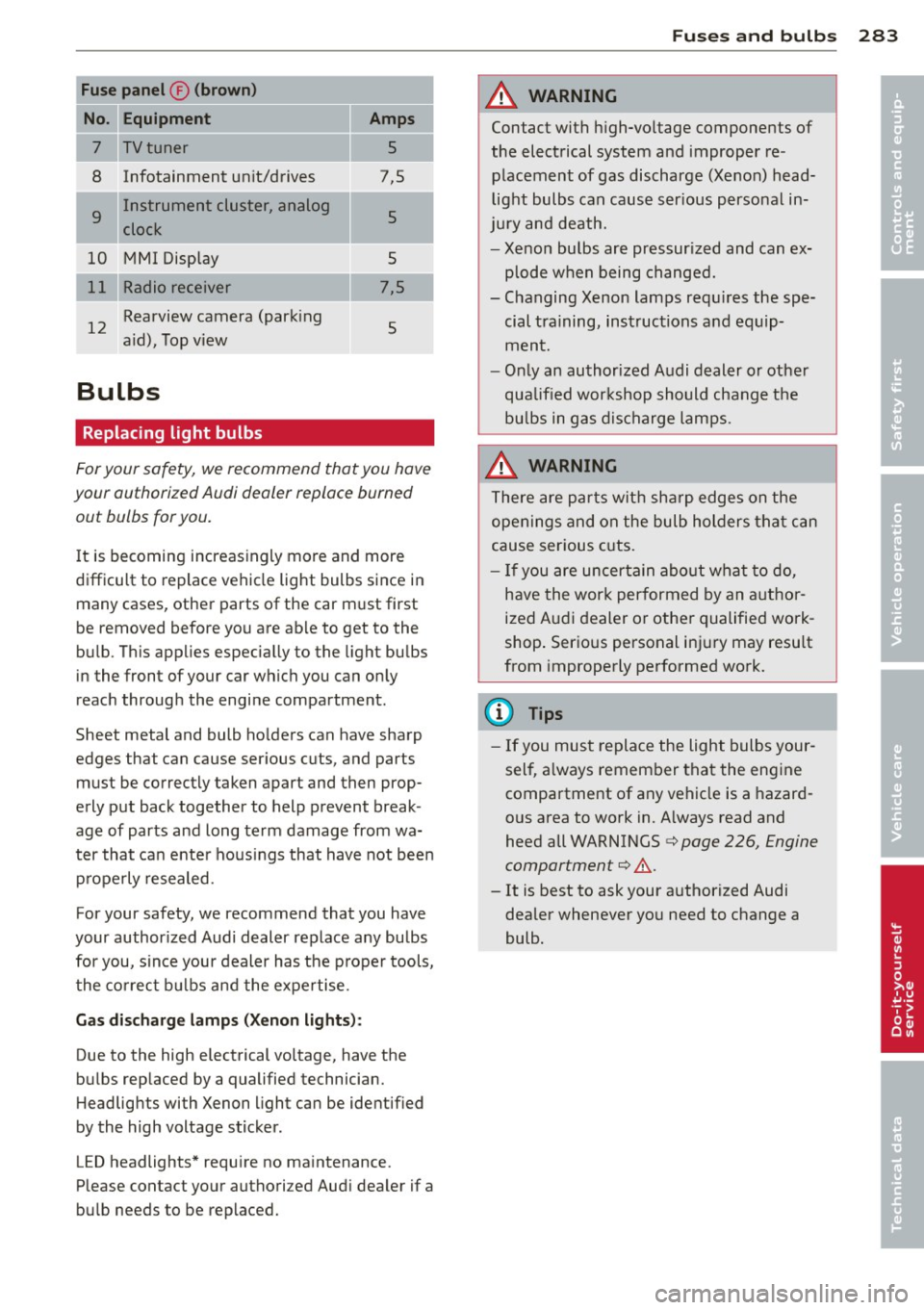
Fuse panel® (brown)
No. Equipment Amps
= ' =
7 TV tuner 5
8 Infotainment unit/drives 7,5
9
Instrument cluster, analog
5 clock
10 MMI Display 5
11 Radio receiver 7,5
12
Rearview camera (park ing
5 a id) , Top v iew
Bulbs
Replacing light bulbs
For your safety, we recommend that you hav e
your authorized Audi dealer replace burned out bulbs for you.
It is becoming increasingly more and more
difficu lt to replace vehicle light bulbs since in
many cases, other parts of the car must first
be removed before you are able to get to the
bulb . This applies especially to the light bulbs
in the front of your car which you can only
reach through the engine compartment.
Sheet metal and bulb ho lders can have sharp
edges that can cause serious cuts, and parts must be correctly taken apart and then prop
erly put back together to help prevent break
age of parts and long term damage from wa
ter that can enter housings that have not been
properly resealed .
For your safety, we recommend that you have
your author ized Audi dealer replace any bulbs
for you, since your dealer has the proper tools,
the correct bulbs and the expertise.
Gas discharge lamps (Xenon lights):
Due to the high electrical voltage, have the
bulbs replaced by a qualified technician.
Headlights with Xenon light can be identified
by the high voltage sticker .
LED headlights* requ ire no ma intenance .
Please contact your authori zed Audi dealer if a
bulb needs to be replaced.
Fuses and bulbs
A WARNING
Contact with high-voltage components of
the electrical system and improper re
placement of gas discharge (Xenon) head
light bulbs can cause ser ious personal in
jury and death.
- Xenon bulbs are pressur ized and can ex
plode when being changed.
- Changing Xenon lamps requ ires the spe
cial tra ining, instructions and equip
ment.
- Only an authorized Audi dealer or other
qua lified workshop should change the
bu lbs in gas discharge lamps .
A WARNING
There are parts with sharp edges on the
openings and on the bulb holders that can
cause serious cuts.
- If you are uncertain about what to do,
have the work performed by an author
ized Audi dealer or other qualified work
shop . Serious personal inj ury may result
from improperly performed work.
(D Tips
-If you must replace the light bulbs your
sel f, a lways remember that the engine
compartment of any vehicle is a hazard
ous area to work in. A lways read and
heed all WARNINGS
<=> page 226, Engine
compartment<=> ,&..
- It is best to ask your authorized Audi
dealer whenever you need to change a
bulb.
-
283
•
•
Page 286 of 318

284 Emergency situations
Emergency situations
General
This chapter is intended for trained emer
gency crews and working personnel who
have the necessary tools and equipment to
perform these ope rations.
Starting by pushing or
towing
Q;) Note
Vehicles w ith an automatic transmission
cannot be started by pus hing o r tow ing.
Starting with jumper
cables
If necessary, the engine can be started by
connecting it to the battery of another vehi
cle.
If the engine should fail to start because of a
discharged or weak battery, the battery can be
connected to the battery of
another vehicle,
using a
pair of jumpe r cables to start the en
g ine .
Jumper cables
Use only jumper cables of sufficiently large
cross section to carry the starter current safe
ly. Refer to the manufacturer's specif ications.
Use only jumper cables with
insulated termi
na l clamps which are distinctly marked:
plus(+) cable in most cases colored red
minu s(-) cable
in most cases colored black .
A WARNING
Batteries contain electricity, acid, and gas.
Any of these can cause very serious or fatal
inju ry. Follow the instructions below for
safe handling of your veh icle's battery.
- Always shield you r eyes and avoid lean
ing over the battery whenever possible.
- A discharged battery can freeze at tem
peratures just be low 32 °F (0 °C). Before connecting a
jumper cable, you must
thaw the frozen battery complete ly, oth
erwise it could explode.
- Do not allow battery acid to contact eyes
or skin . Flush any contacted area with
water immediately .
- Improper use of a booster battery to start a vehicle may cause an explosion.
- Vehicle batteries generate explosive gas
es. Keep sparks, flame and lighted ciga
rettes away from batteries.
- Do not try to jump start any vehicle with a low acid level in the battery.
- The vo ltage of the booster battery must
also have a 12-Volt rating. The capacity
(Ah) of the booster battery should not be
lower than that of the discharged bat
tery . Use of batteries of d ifferent voltage
or substantially different "Ah" rating
may cause an exp losion and personal in
jury.
- Never charge a frozen batte ry. Gas trap
ped in the ice may cause an explosion.
- Never charge or use a battery that has
been frozen. The battery case may have
be weakened.
- Use of batter ies of different voltage or
substantially different capacity (Ah) rat
ing may cause an exp losion and injury.
The capacity (Ah) of the booster battery
should not be lower than that of the dis
charged battery.
- Before you check anything in the engine
compartment, always read and heed a ll
WARNINGS¢
page 226 , Engine com
partment.
«I) Note
-Applying a higher voltage booster bat
tery will cause expensive damage to sen
sitive electronic components, such as
contro l units, relays, rad io, etc .
- There must be no electrical contact be
tween the vehicles as otherwise current
could already start to flow as soon as the
positive(+) terminals are connected. ..,_
Page 287 of 318
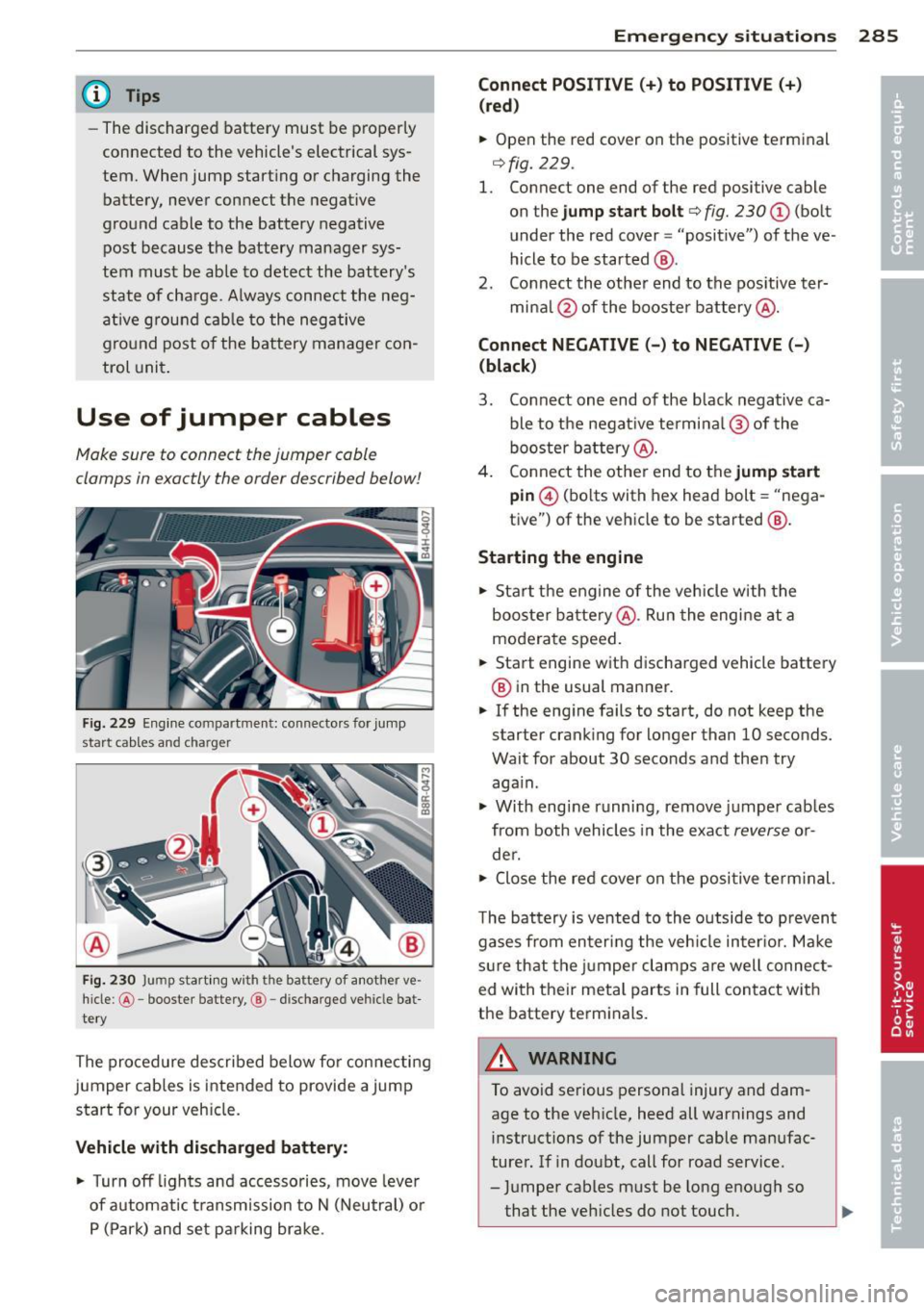
@ Tips
- The discharged battery must be properly
connected to the vehicle's electrical sys
tem. When jump start ing or charging the
battery, never connect the negative
ground cable to the battery negative post because the battery manager sys
tem must be able to detect the battery's
state of cha rge. A lways connect the neg
ative g round cab le to the negative
gro und post o f the battery manage r con
trol uni t.
Use of jumper cables
Make sure to connect the jumper coble
clomps in exactly the order described below!
Fig. 229 Engine compartment: connecto rs for jump
start cables and charger
Fi g. 230 Jump start ing w ith the battery of another ve
hicle: @-booste r batte ry, @ -discharged vehicle bat
te ry
The procedure described below fo r connecting
jumper cab les is intended to provide a jump
start for your veh icle.
Vehicle with discharged batt ery:
.. Turn off lights and acc esso ries, move leve r
of automat ic t ransm ission to N (Neutral) o r
P (Park) and set pa rking brake .
Emergenc y situ ation s 285
Connect POSI TIVE(+) to POSITIVE (+ )
(red )
.. Open the red cover on the positive terminal
¢fig. 229.
1. Connect one end of the red positive cable
on the
jump sta rt bolt ¢ fig. 230 (D (bolt
under the red cover = "positive") of the ve
hicle to be started @.
2. Co nnect th e other end to the pos itive ter-
mina l@ of the booster battery @.
Connect NEGATIVE( -) to NEGATIVE(-)
(black )
3. Connect one end of the black negative ca ble to the negat ive termina l@ of the
booster b attery @.
4 . Connect the othe r end to the
jump start
pin @ (bolts with hex head bolt = "nega
tive") of the vehicle to be started @.
Starting the engine .. Sta rt the engine of the veh icle w ith the
booste r ba ttery @. Ru n the engine at a
moderate speed .
.. Start engine wit h discha rged vehicle battery
@ in the usual manner .
.. If the eng ine fails to start, do not keep the
starter cranking for longer than 10 seconds.
Wait for about 30 seco nds a nd the n try
aga in .
.. With engi ne runni ng, remove j umper cab les
from both vehicles in the exact
reverse o r
de r .
.. Close the red cover on the positive term inal.
T he battery is vented to th e outside to p rev ent
gases from en ter ing the veh icle in ter io r. Ma ke
s ur e th at the j umper clamps are well connec t
ed with their meta l parts in full con ta ct w ith
the battery term inals.
A WARNING
To avoid se rious personal injury and dam
age to the veh icle, heed all warnings and
instructions of the jumper cable man ufac
turer. If in doubt, call for road service .
- J umper cables m ust be long enough so
that the veh icles d o not touch.
-
Page 288 of 318
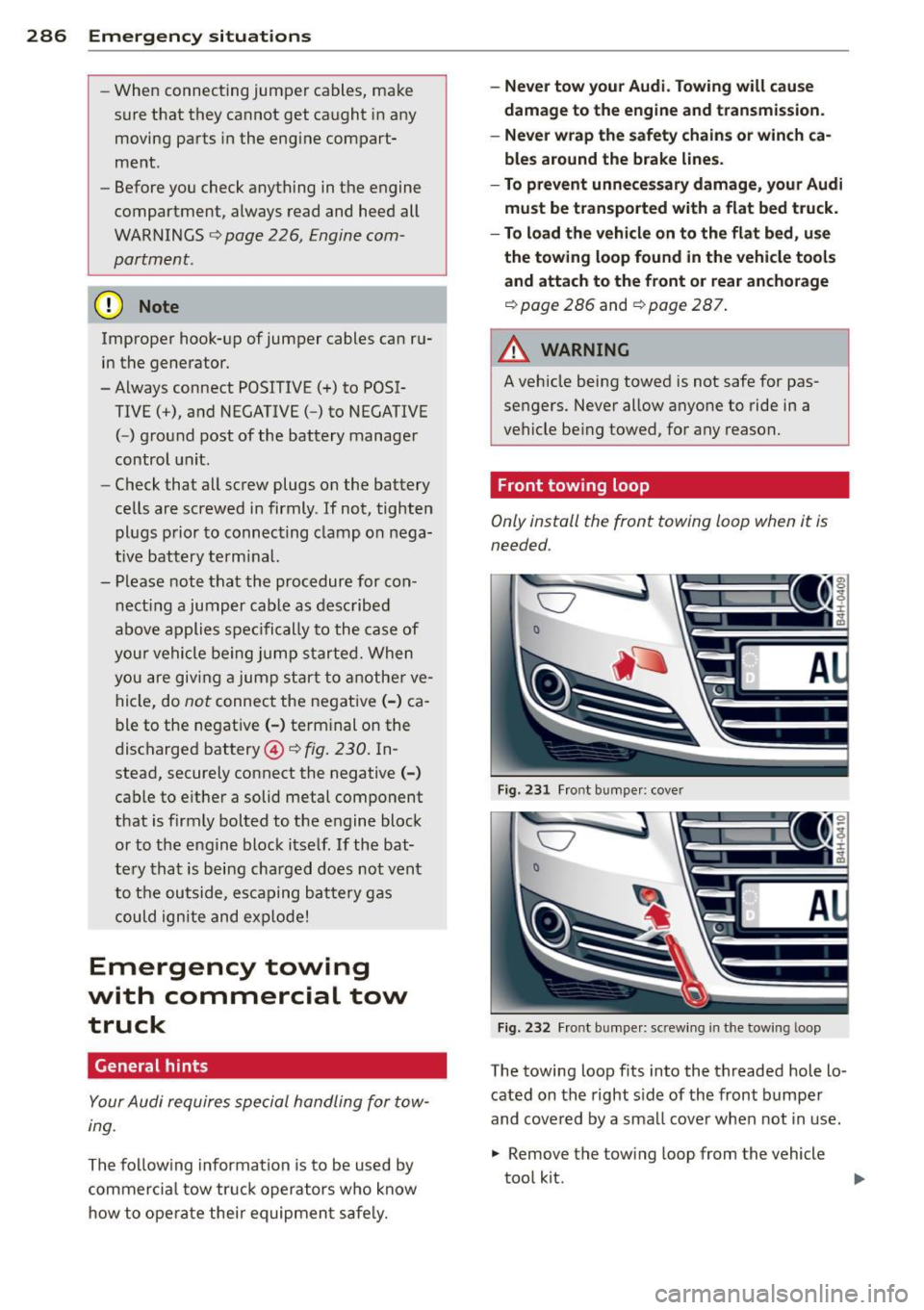
286 Emergency situations
-When connecting jumper cables, make
sure that they cannot get caught in any
moving parts in the engine compar t
ment .
- Before you check anything in the engine
compartment, always read and heed all
WARNINGS
c:> page 226 , Engine com
partment.
(D Note
Improper hook-up of jumper cables can ru
in the generator.
- Always connect POSITIVE(+) to POSI
TIVE( +), and NEGATIVE( -) to NEGATIVE
( - ) ground post of the battery manager
control unit.
- Check that all screw plugs on the battery
cells are screwed in firmly . If not, tighten
plugs prior to connecting clamp on nega
tive battery terminal.
- Please note that the procedure for con
necting a jumper cable as described
above applies specifically to the case of
your vehicle being jump started. When
you are giving a jump start to another ve
hicle, do
not connect the negative(-) ca
ble to the negative(-) terminal on the
discharged battery ©
c:> fig. 230. In
stead, securely connect the negative(-)
cable to either a solid metal component
that is firmly bolted to the engine block
or to the engine block itself . If the bat
tery that is being charged does not vent
to the outside, escaping battery gas
could ignite and explode!
Emergency towing
with commercial tow
truck
General hints
Your Audi requires special handling for tow
tng.
The following information is to be used by
commercial tow truck operators who know
how to operate their equipment safely.
-Never tow your Audi. Towing will cause
damage to the engine and transmission.
- Never wrap the safety chains or winch ca
bles around the brake lines.
- To prevent unnecessary damage, your Audi
must be transported with a flat bed truck.
- To load the vehicle on to the flat bed, use
the towing loop found in the vehicle tools
and attach to the front or rear anchorage
c:> pag e 286 and c:> page 287.
.&_ WARNING
=
A vehicle being towed is not safe for pas-
sengers. Never allow anyone to ride in a
vehicle being towed, for any reason.
Front towing loop
Only install the front towing loop when it is
needed .
C7
0
Fig. 231 Front bumper: cover
Fig. 232 Front bumper : sc rewing in th e towin g loop
-
The towing loop fits into the threaded hole lo
cated on the right side of the front bumper
and covered by a small cover when not in use.
.,. Remove the towing loop from the veh icle
tool kit.
Page 291 of 318
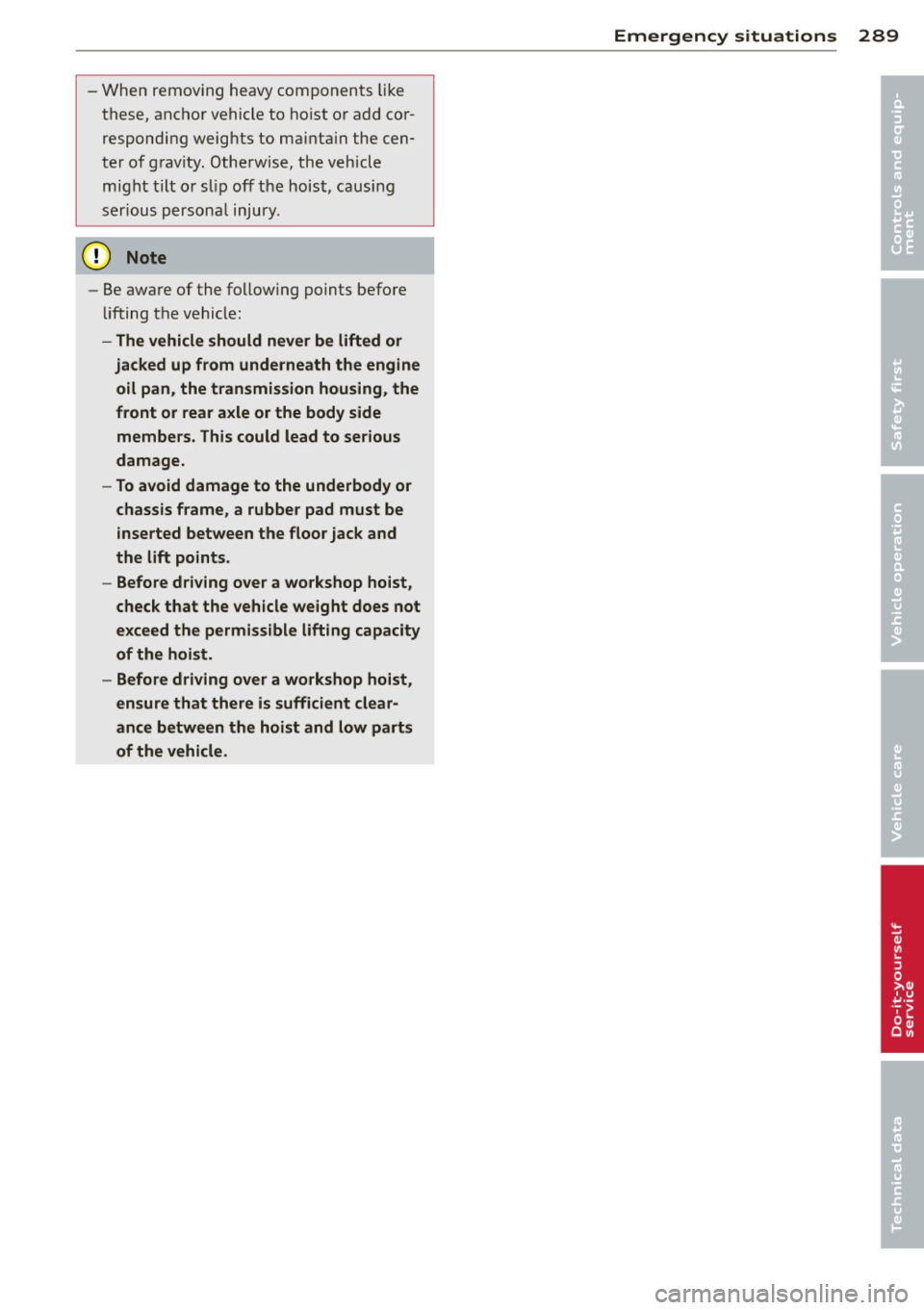
-When removing heavy components like
these, anchor vehicle to hoist o r add cor
respond ing weig hts to mai nta in the cen
ter of g ravity. Otherwise, the vehicle
m ight tilt o r slip off the hois t, causi ng
ser ious persona l injury .
Q) Note
-Be awa re of the fo llow ing points befo re
li fting t he vehicle:
- The vehicle should never be lifted or
jacked up from underneath the engine
oil pan, the transmission housing , the
front or rear axle or the body side members. This could lead to serious
damage.
- To avoid damage to the underbody or
chassis frame, a rubber pad must be
i nserted between the floor jack and
the lift points .
- Before driv ing over a workshop hoist,
check that the veh icle weight does not
exceed the permissibl e lifting capacity
of the hoist.
- Before driving over a workshop hoist,
ensure that there is sufficient clear ance between the hoist and low parts
of the vehicle.
Emergency situations 289
•
•
Page 292 of 318
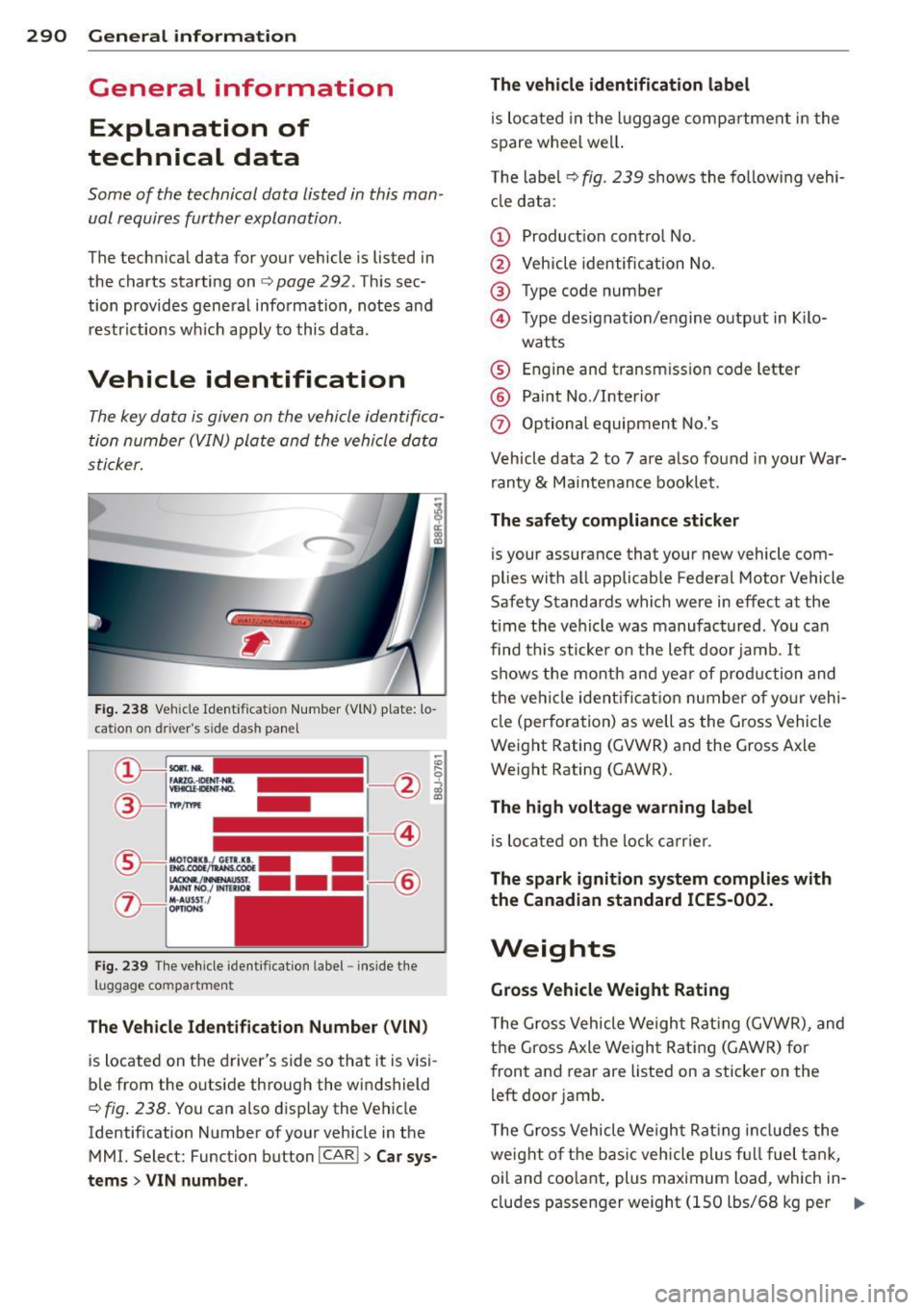
2 90 General information
General information Explanation of
technical data
Some of the technical data listed in this man
ual requires further explanation .
The technical data for your vehicle is listed in
the charts starting on
r:::> page 292. This sec ·
tion provides general information, notes and restrictions which apply to this data .
Vehicle identification
The key data is given on the vehicle identifica·
tion number (VIN) plate and the vehicle data
sticker.
Fig. 238 Veh icle Ide ntific atio n Number (VlN) p late: lo
cation on driver 's sid e das h panel
Fig. 239 The vehicle identi fication label -inside the
luggage co mpa rtmen t
The Vehicle Identification Number (VIN)
is located on the driver's side so that it is visi
b le from the outside through the windshield
r:::> fig . 238. You can also display the Vehicle
Identification Number of your vehicle in the
MMI. Select: Function button
ICAR ! > Car sys
tems
> VIN number . The
vehicle identification label
is located in the luggage compartment in the
spare wheel wel l.
The label¢
fig. 239 shows the following vehi
cle data :
(D Production control No .
@ Vehicle identification No.
® Type code number
@ Type designation/engine output in Kilo·
watts
® Engine and transmission code letter
@ Paint No./Interior
(f) Optional equipment No.'s
Vehicle data 2 to 7 are also found in your War·
ranty
& Maintenance booklet.
The safety compliance sticker
is you r assurance that your new vehicle com
plies with all applicable Federal Motor Vehicle
Safety Standards which were in effect at the
time the vehicle was manufactured . You can
find this sticker on the left door jamb.
It
shows the month and year of production and
the ve hicle ident ification number of your vehi ·
cle (perforation) as well as the Gross Vehicle
Weight Rating (GVWR) and the Gross Axle
Weight Rating (GAWR) .
The high voltage warning label
is located on the lock carr ier .
The spark ignition system complies with
the Canadian standard ICES-002.
Weights
Gross Vehicle Weight Rating
The Gross Vehicle Weight Rating (GVWR), and
the Gross Axle Weight Rating (GAWR) for
front and rear are Listed on a sticker on the
left door jamb.
The Gross Vehicle Weight Rating includes the
weight of the basic vehicle plus full fuel tank,
oi l and coolant, plus maximum load, wh ich in·
eludes passenger weight (lSO lbs/68 kg per
Ill>
Page 294 of 318
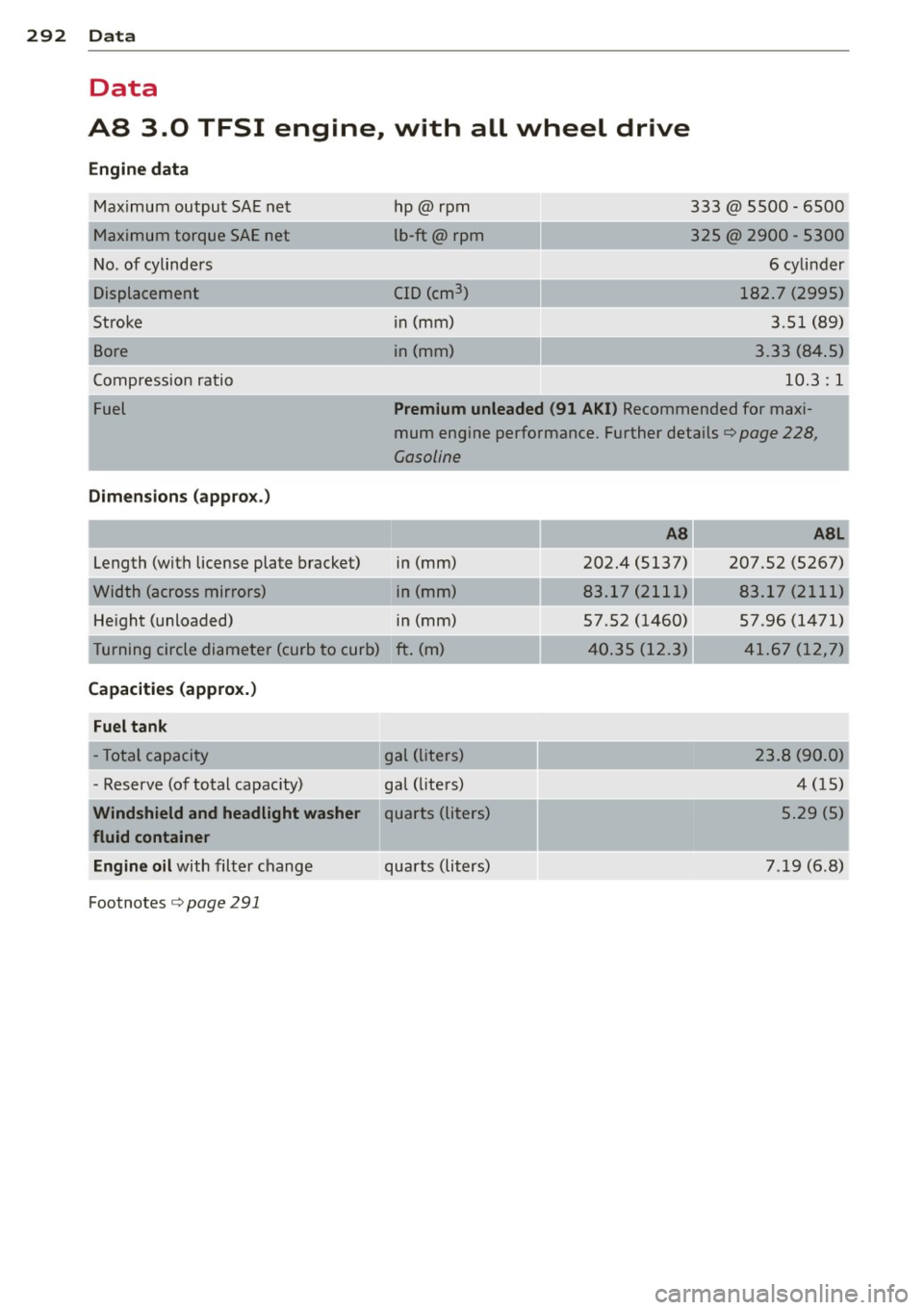
292 Data
Data
AS 3.0
TFSI engine, with all wheel drive
Engine data
Maximum outpu t SA E net
Maximum torque SAE net
N o. of cylinders
Displacement
Stroke
Bore
C ompression ratio hp@rpm
l
b-ft@ rpm
CID (cm
3 )
in (mm)
i n (mm)
333 @ 5500 - 6500
325
@ 2900 - 5300
6 cyli nder
182.7 (2995)
3.51 (89)
3.33 (8 4.5)
10.3: 1
Fuel Premium unleaded (91 AKI)
Recommended for maxi
mum engine performance. Further details
c:::> page 228,
Gasoline
Dimens ions (approx .)
Length (with license plate bracket) in (mm)
W idth (across mirrors) ____ in (mm)
He ight (unloaded) in (mm)
Turning circle diameter (curb to curb) ft . (m )
Capacities (approx.)
Fuel tank
- Total capacity gal (liters)
- Res erve (of total capacity) gal (lite rs)
Windshield and headlight washer quarts (liters)
fluid container
Engine oil with filter c hang e quarts (lit ers)
Footnotes
c:::> page 291
AS ASL
202.4 (5137) 207.52 (5267) _,, __
83 .1 7 (2 11 1) 83.17 (211 1)
57.52 (1460) 57 .96 (1471)
4 0.3 5 (12 .3) 41.67 (1 2,7 )
23.8 (90 .0)
4 (15)
5 .29 (5)
7.1 9 (6.8)
Page 295 of 318
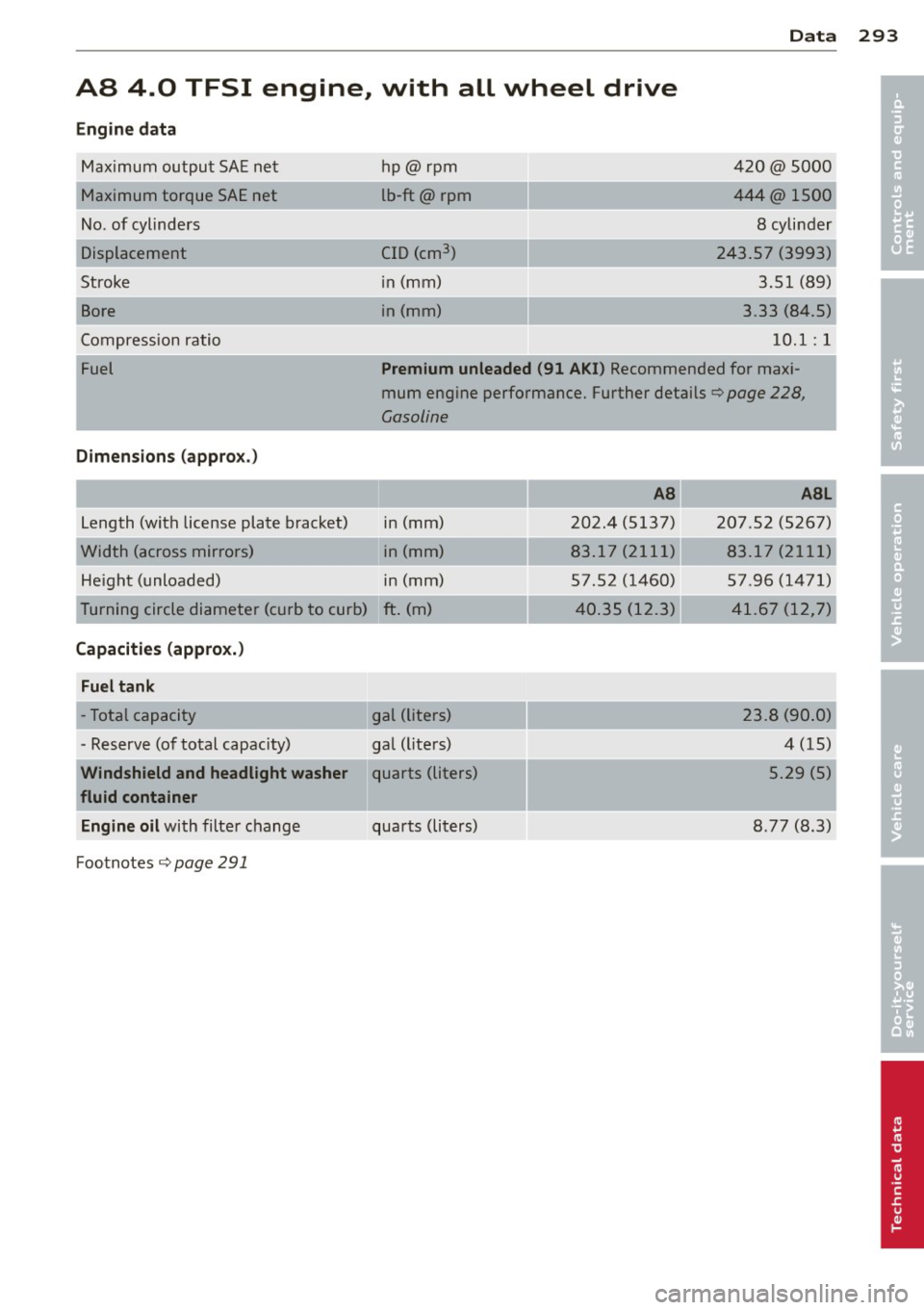
AS 4.0 TFSI engine., with all wheel drive
Engine data
Maximum output SAE net
Maximum torque SAE net
No . of cylinders
Displacement
Stroke
Bore
Compression ratio hp@rpm
lb-ft@ rpm
CID (cm
3 )
in (mm)
in (mm)
Data
420@5000
444@1500
8 cylinder
243.57 (3993) 3.51 (89)
3 .33 (84.5)
10.1 : 1
Fuel Premium unleaded (91 AKI) Recommended for maxi
mum engine performance. Further details¢
page 228,
Gasoline
Dimensions (approx .)
Length (with license plate bracket)
Width (across mirrors)
He ight (unloaded) in (mm)
in (mm)
in (mm)
T urning circle diameter (curb to curb) ft . (m)
Capacities (approx.)
Fuel tank
- Total capacity gal (liters)
- Reserve (of total capacity) gal (l iters)
__ _.. __
Windshield and headlight washer quarts (liters)
fluid container
Engine oil with filter change
Footnotes
¢ page 291
quarts (liters)
AS
202.4 (5137)
83.17 (2111)
57 .52 (1460)
-....... -
4 0.35 (12.3)
ASL
207 .52 (5267)
83.17 (211 1)
57 .96 (1471)
41.67 (12,7)
23 .8 (90 .0)
4 (15)
5 .29 (5)
8 .77 (8.3)
293
•
•
Page 296 of 318
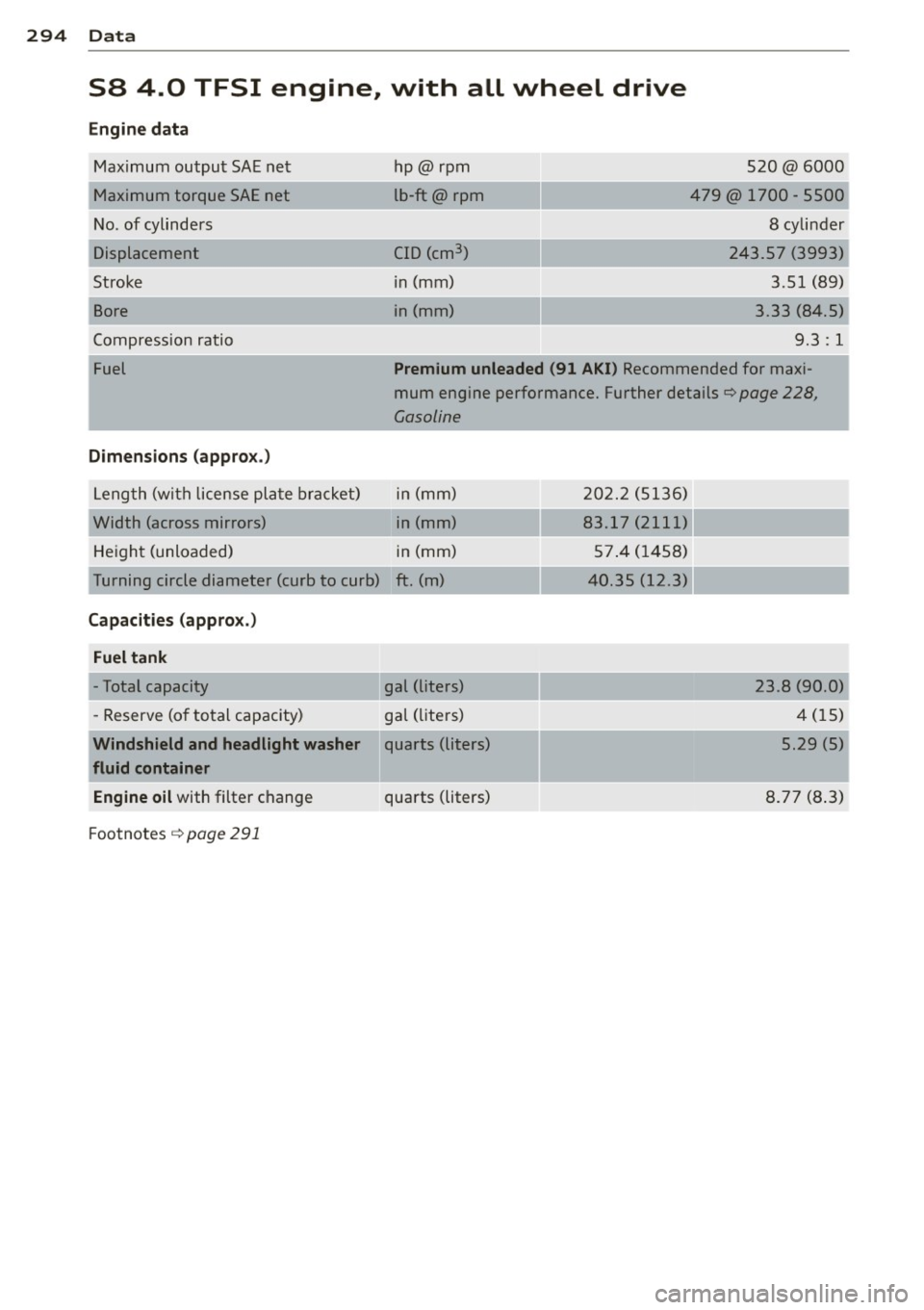
294 Data
S8 4.0 TFSI engine, with all wheel drive
Engine data
Maximum output SAE net
Maximum torque SAE net
N o. of cylinders
Displacement
Strok e
Bore
C ompression ratio hp@rpm
l
b-ft@ rpm
CID (cm
3 )
in (mm)
i n (mm)
520@6000
479@ 1700 - 5500
8 cylinder
243 .57 (3993)
3.51 (8 9)
3.33 (84 .5)
9.3 : 1
Fuel Premium unleaded (91 AKI) Recommended for maxi
mum engine performance. Further details
Q page 228,
Gasoline
Dimensions (approx .)
Leng th (wit h license pl ate brac ket) in (mm)
Width (across mirrors) in (mm)
He igh t (unloaded) in (mm)
T urning circle diamet er (curb to curb) ft. (m)
Capacities (appro x.)
Fuel tank
- Total capacity gal (liters)
- Reserve (o f to tal capacity) gal ( lite rs)
Windshield and headlight washer quarts (liters)
fluid container
Engine oil with filter change quarts (liters)
F oo tnotes
Q page 291
2 02 .2 (51 36)
83.17 (2111) 57.4 (1458)
4 0.35 (12.3)
23.8 (90.0)
4 (15)
5.29 (5)
8. 77 (8 .3)
Page 297 of 318
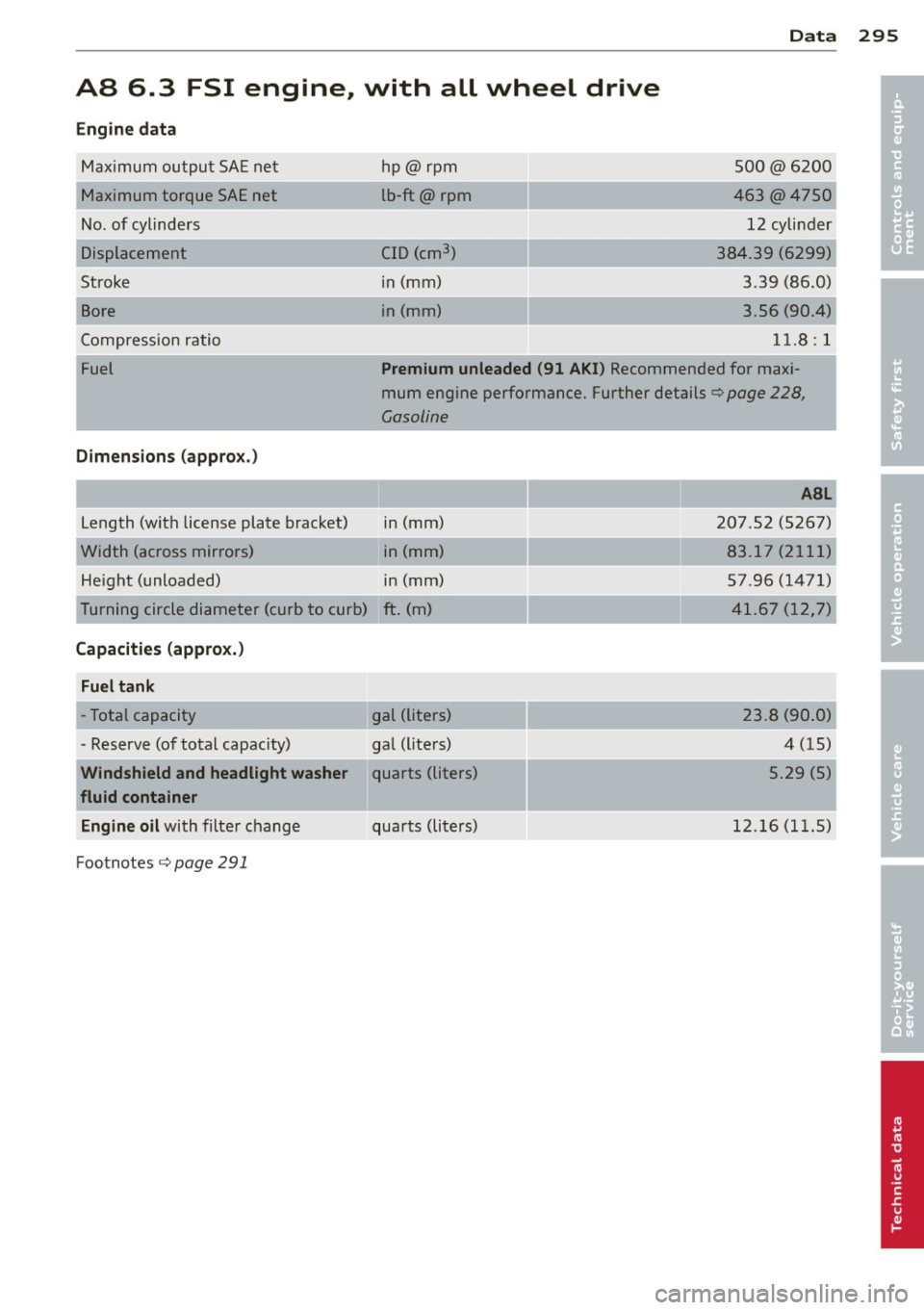
AS 6.3 FSI engine, with all wheel drive
Engine data Maximum output SAE ne t
M aximum torque SAE net
No . of cylinders
Displacement
Stroke
Bore
Compression ratio hp@r
pm
lb-ft@ rpm
CID (cm
3 )
in (mm)
in (mm)
Data
500@6200
4 63@4750
12 cylin der
384.39 (6299)
3.39 (86.0)
3 .56 (90 .4)
1 1. 8:1
Fuel Premium unleaded (91 AKI) Recommended for maxi
mu m engine performance. Further details¢
page 228,
Gasoline
Dimension s (approx .)
Length (with license plate bracket)
W idth (across mirro rs)
He ight (unloaded) in (mm)
in (mm)
in (mm)
T urning circle diameter (curb to curb) ft . (m )
Capacities (approx.)
Fuel tank
-Total capacity gal (liters)
- Reserve (of to tal capacity) gal (l ite rs)
Windshield and headlight washer quarts (liters)
fluid container
Engine oil with filter chang e
Footnotes
¢ page 291
quarts (li ters)
ASL
207 .52 (5267)
83.1 7 (211 1)
57 .96 (1471)
4 1.67 (1 2,7)
23 .8 (90 .0)
4 (15 )
5 .29 (5)
12 .16 (1 1.5)
295
•
•